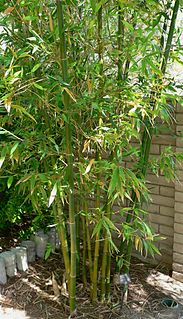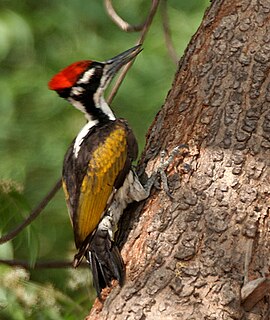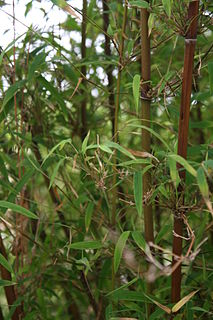
Bambusa is a large genus of clumping bamboos. Most species of Bambusa are rather large, with numerous branches emerging from the nodes, and one or two much larger than the rest. The branches can be as long as 11 m (35 ft).

Drepanostachyum is an Asian genus of medium-sized mountain clumping bamboos in the grass family. They are native to China, Indochina, and the Indian Subcontinent.

Thamnocalamus is a genus of clumping bamboo in the grass family. These species are found from the Himalayas as well as Madagascar and Southern Africa.

Chrysocolaptes is a genus of birds in the woodpecker family Picidae that are found in South and Southeast Asia.

The jungle myna is a myna, a member of the starling family. It is found patchily distributed across much of the mainland of the Indian Subcontinent but absent in the arid zones of India. It is easily recognized by the tuft of feathers on its forehead that form a frontal crest, a feature also found in the closely related Javan myna and the pale-bellied myna which were treated as a subspecies in the past. The eyes are pale, yellow or blue depending on the population and the base of the orange-yellow bill is dark. It has also been introduced either intentionally or accidentally into many other parts of the world including Fiji, Taiwan, the Andaman Islands, and parts of Japan. The species has also spread out on its own to some islands in the Pacific.

James Wood-Mason was an English zoologist. He was the director of the Indian Museum at Calcutta, after John Anderson. He collected marine animals and lepidoptera, but is best known for his work on two other groups of insects, phasmids and mantids.

James Prinsep FRS was an English scholar, orientalist and antiquary. He was the founding editor of the Journal of the Asiatic Society of Bengal and is best remembered for deciphering the Kharosthi and Brahmi scripts of ancient India. He studied, documented and illustrated many aspects of numismatics, metallurgy, meteorology apart from pursuing his career in India as an assay master at the mint in Benares.

Yushania is a genus of bamboo in the grass family.
Blumeodendron is a genus of dioecious trees of the family Euphorbiaceae first described as a genus in 1873. It is widespread across much of Southeast Asia and Papuasia.

Acidosasa is a genus of East Asian bamboo in the grass family.

Himalayacalamus is an Asian genus of mountain clumping bamboo in the grass family. Species members are found growing at lower altitudes of the Himalaya in Bhutan, Tibet, India, and Nepal.
Gelidocalamus is a genus of small to medium-sized bamboos in the grass family, native primarily to the mountains of eastern China, although one species (G. kunishii) is native to Taiwan and to the Nansei-shoto region in Japan.

Thyrsostachys is a genus of Chinese and Indochinese bamboo in the grass family.
- Thyrsostachys oliveri Gamble - edible-seeded bamboo - Yunnan, Myanmar, Laos, Thailand; naturalised in Assam + Bangladesh
- Thyrsostachys siamensis Gamble - monastery bamboo, Thai bamboo, umbrella bamboo, Thai umbrella bamboo, umbrella-handle bamboo - Yunnan, Myanmar, Laos, Thailand, Vietnam; naturalised in Sri Lanka, Bangladesh, Peninsular Malaysia
Charles Lionel Augustus de Nicéville was a curator at the Indian Museum in Calcutta. He studied the butterflies of the Indian Subcontinent and wrote a three volume monograph on the butterflies of India, Bangladesh, Nepal, Burma and Sri Lanka. He also studied the mantids of the Oriental region.
Blythia reticulata, commonly known as Blyth's reticulate snake, Blyth's reticulated snake, or the iridescent snake, is a species of snake in the subfamily Natricinae of the family Colubridae of the superfamily Colubroidea. The species is endemic to Asia.

Nepenthes singalana is a tropical pitcher plant endemic to the island of Sumatra, where it grows at 2000–2900 m above sea level. It is most closely allied to N. diatas and N. spathulata.

James Sykes Gamble was an English botanist who specialized in the flora of the Indian sub-continent; he became Director of the British Imperial Forest School at Dehradun, and a Fellow of the Royal Society.

Cleghornia is a genus of plants in the family Apocynaceae; its various species are distributed in Borneo, China, Laos, Malaysia, Sri Lanka, Thailand, and Vietnam.
Ischnostemma is a genus of flowering plants of the family Apocynaceae, first described as a genus in 1908. It is native to Southeast Asia.
- Ischnostemma carnosum (R.Br.) Merr. & Rolfe - Luzon Island in Philippines
- Ischnostemma selangorica King & Gamble - Selangor in Peninsular Malaysia
Bashania is a genus of East Asian bamboo in the grass family, native to China and Vietnam.
- Bashania abietinaT.P.Yi & L.Yang – Sichuan
- Bashania fansipanensisT.Q.Nguyen – Vietnam
- Bashania fargesii(E.G.Camus) Keng f. & T.P.Yi – Gansu, Hubei, Shaanxi, Sichuan
- Bashania qingchengshanensisKeng f. & T.P.Yi – Sichuan













